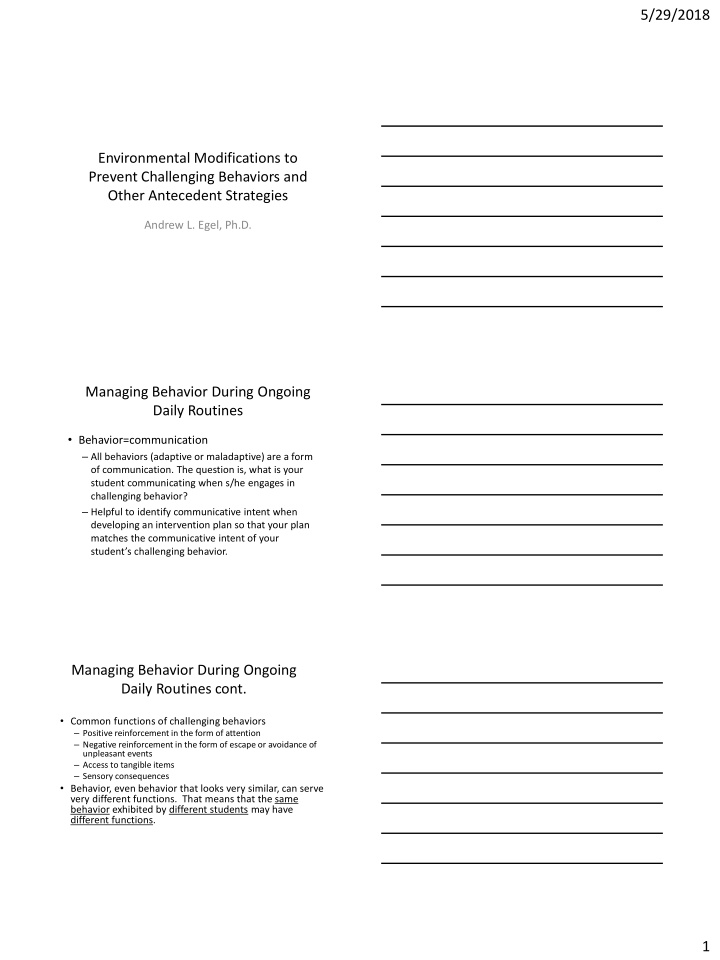



5/29/2018 Environmental Modifications to Prevent Challenging Behaviors and Other Antecedent Strategies Andrew L. Egel, Ph.D. Managing Behavior During Ongoing Daily Routines • Behavior=communication – All behaviors (adaptive or maladaptive) are a form of communication. The question is, what is your student communicating when s/he engages in challenging behavior? – Helpful to identify communicative intent when developing an intervention plan so that your plan matches the communicative intent of your student’s challenging behavior. Managing Behavior During Ongoing Daily Routines cont. • Common functions of challenging behaviors – Positive reinforcement in the form of attention – Negative reinforcement in the form of escape or avoidance of unpleasant events – Access to tangible items – Sensory consequences • Behavior, even behavior that looks very similar, can serve very different functions. That means that the same behavior exhibited by different students may have different functions. 1
5/29/2018 Managing Behavior During Ongoing Daily Routines cont. • Purpose of Functional Behavior Assessment (FBA) is to identify the function/communicative intent of challenging behaviors. • This information will help guide the interventions designed in the Behavioral Intervention Plan (BIP). – Typically a BIP will describe procedures for • Teaching new replacement skills • Strategies for responding so that new skills are maintained and acknowledged. • Strategies for modifying the curriculum, environment, activity, or interactions to prevent the occurrence of the behavior. • I will focus today on strategies for preventing the occurrence of challenging behaviors Preventing • Prevention strategies reduce the likelihood that the student will need or want to use the challenging behavior. Prevention Questions • How can the environment be changed to reduce the likelihood that the behavior will occur? • What procedures can I select that fit in with the natural routines and structure of the classroom or family? • How can I build on what works? • What can be done to help the student respond to or avoid behavior triggers? 2
5/29/2018 Possible Prevention Strategies • Advanced reminder of transition times/Safety signal – Important because it does not require an abrupt switch from one activity to another which may lead to challenging behavior. – Verbal reminder, set a timer, use picture cues, etc. • Anticipate situations that are likely to lead to challenging behaviors – Identify requests that lead to challenging behavior and show in advance what your student will receive after they complete your request. • Make sure that your instructions are in the form of a statement rather than a question (e.g., “Are you ready to put your shoes on?” vs. “It is time to put your shoes on”) unless you are truly offering a choice. • Offering choices using pictures or actual objects. • Select reinforcer prior to activity (“when you put the toy away, you can go outside ”; “what do you want to work for?”). Preventing Behaviors Maintained by Attention (Socially mediated positive reinforcement) • Create a rich, reinforcing environment and provide frequent attention (praise, smiles, hugs, tickles) for all appropriate behavior • Teach an appropriate means of requesting attention (e.g., vocalization, ASL sign, PECS) and provide the attention contingent upon this new replacement behavior Preventing Behaviors Maintained By Student Escaping/Avoiding Something Unpleasant (Socially Mediated Negative Reinforcement ) • Create a visual schedule, allowing students the opportunity to anticipate future activities • Imbed choices within less preferred activities • Use a timer to indicate how long a student must engage in the less preferred activity before he can move on to a preferred activity • When appropriate, teach students to request a break from a less preferred activity or teach them to ask for help 3
5/29/2018 Manipulation of Antecedents • Antecedents are stimuli, events, or conditions that are present before a behavior occurs. – People – Time of day – Physical environment – Absence of stimuli Why Use Antecedent Interventions? • Antecedent interventions reduce the likelihood that challenging behaviors will occur. • Antecedent interventions decrease or eliminate challenging behaviors by – Eliminating the antecedent event – Modifying the antecedent event – Changing how antecedent events are presented Prevent: Simplifying and/or Modifying Activities • Alter task demands by simplifying or modifying activities • Schedule preferred activities following non-preferred activities • Limit choices available 4
5/29/2018 Prevent: Clarifying and Communicating Expectations Use visuals to clarify schedule Math Warm-up Break Reading Prevent: Clarifying and Communicating Expectations • Use visuals to help clarify choices Library Writing Table Toys Prevent: Clarifying and Communicating Expectations Provide verbal or visual prompts or reminders Use scripted routines Use scripted responses 5
Recommend
More recommend